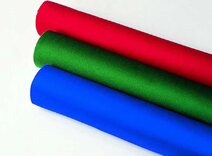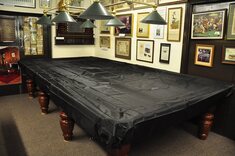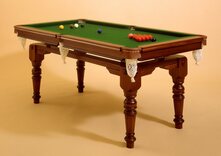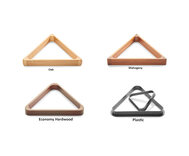The Rules of Billiards
The following is a basic set of instructions for the friendly play of the game of Billiards including additional comments designed to assist with the understanding of the game. Note: 1 foot = 30.48 cm
See also: Buy Snooker Tables, Equipment & Accessories.
Billiards
Equipment
A full-size Billiards table measures twelve feet by six feet, one and a half inches and has a baize-covered slate bed. The four edges of the table feature rubber edges covered in baize called "cushions". Six "pockets" are situated one at each corner plus one at the centre of each long side of the table into which the balls can drop. The six pockets normally have a net or a small collecting channel to catch the balls. Two feet, five inches from one end, a line is drawn across the table called the "baulk" line. Any ball between the baulk line and the nearest end is generally referred to as being "in baulk". A semi-circle is inscribed within the baulk area with is axis as the middlepoint of the baulk line and with a radius of eleven and a half inches. This semi-circle is termed the "D". At the other end of the table, twelve and three-quarter inches from the end cushion, a spot is centrally inscribed as a starting point for the red ball. The cue ball is struck with tapered sticks featuring a striking tip called "cues". The cue tips are chalked to prevent a slippery contact with the ball. There is almost always an additional accessory available called a "rest" which is like a cue with a cross on the end upon which the cue can be rested to extend its playing length. Quite often, a "full-butt" and a "half-butt" are also available - these are much longer rests with arched fixments on the end that come with their own long cues for playing very long shots. Billiards is played with one red ball and two white cue balls, one with a small black spot and one without.
The Start
A doubles game is occasionally played but the game is usually singles. One player chooses to play with the white cue ball and the other the spotted white cue ball. To begin with, players play their cue ball from within the D down the table so that it bounces back up the table and comes to rest in baulk. The player whose ball is closest to the baulk cushion chooses to go first or second. Most players prefer to go second because the first turn occurs with only two balls on the table - a severe limitation. The game starts with the red ball on it's spot and the cue ball of the starting player placed in the D at the front of the table. Players agree how many points will constitute a game and the objective is merely to be the first to score than number. A typical number for expert players might be 1000 points - professionals regularly score more than this in a single break. Beginners might consider 150 as a more appropriate target.
Basic Play
Each turn is called a "break" and consists of a series of strikes of the cue ball that come to an end when a player makes a non-scoring strike or a foul stroke. Scoring is achieved by "potting" balls, by "cannons", and by going "in off". A ball is "potted" when the cue ball knocks it into a pocket. A "cannon" is when the cue ball strikes first one ball and then the other. A player's ball goes "in off" when it falls into a pocket having first "kissed" (struck) another ball. Whenever the red ball is potted, it is immediately returned to the red spot for the next strike. Whenever the cue ball goes in off, it is immediately returned to the player who can position it anywhere within the D for the next strike. If the opponents ball is potted, it remains out of play until the end of that player's break. In this case, the opponent starts the next turn by positioning his ball anywhere within the D. Otherwise the opponent starts the next turn by striking the ball from wherever it ends up. Potting the opponents ball is usually to be avoided since scoring is much harder with only two balls on the table.
Foul shots
A foul occurs when a player's ball hits no other balls in which case 1 point is added to the opponent's score or when the player's ball goes directly into a pocket without hitting any other ball whereupon 3 points are given to the opponent. It will quickly be seen, however, that the size of these penalties are trivial compared to the injury suffered merely as a result of allowing the opponent onto the table.....
Scoring
- 3 points for potting or going in off the red ball.
- 2 points for potting or going in off the opponents ball.
- 2 points for a cannon.
Special Situations
When the player's ball finishes touching another ball, the red is put on its spot, the other player's white is placed on the centre spot, and the player must return his ball to the D.
These rules are provided by Masters Traditional Games, an Internet shop selling quality traditional games, pub games and unusual games. For general information or for copying and copyright, see our Rules Information page.
Our rules are comprehensive instructions for friendly play. If in doubt, always abide by locally-played or house rules.
Copyright James Masters, 2025. All rights reserved.





































